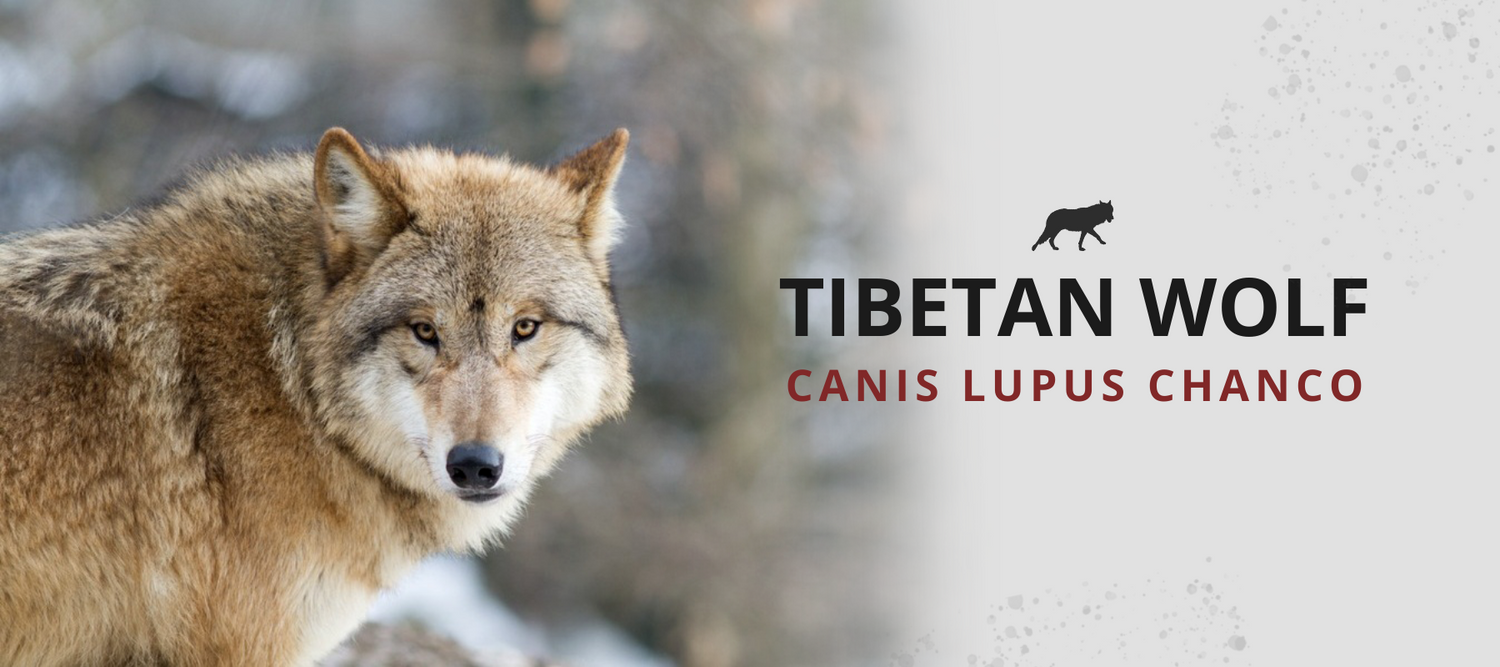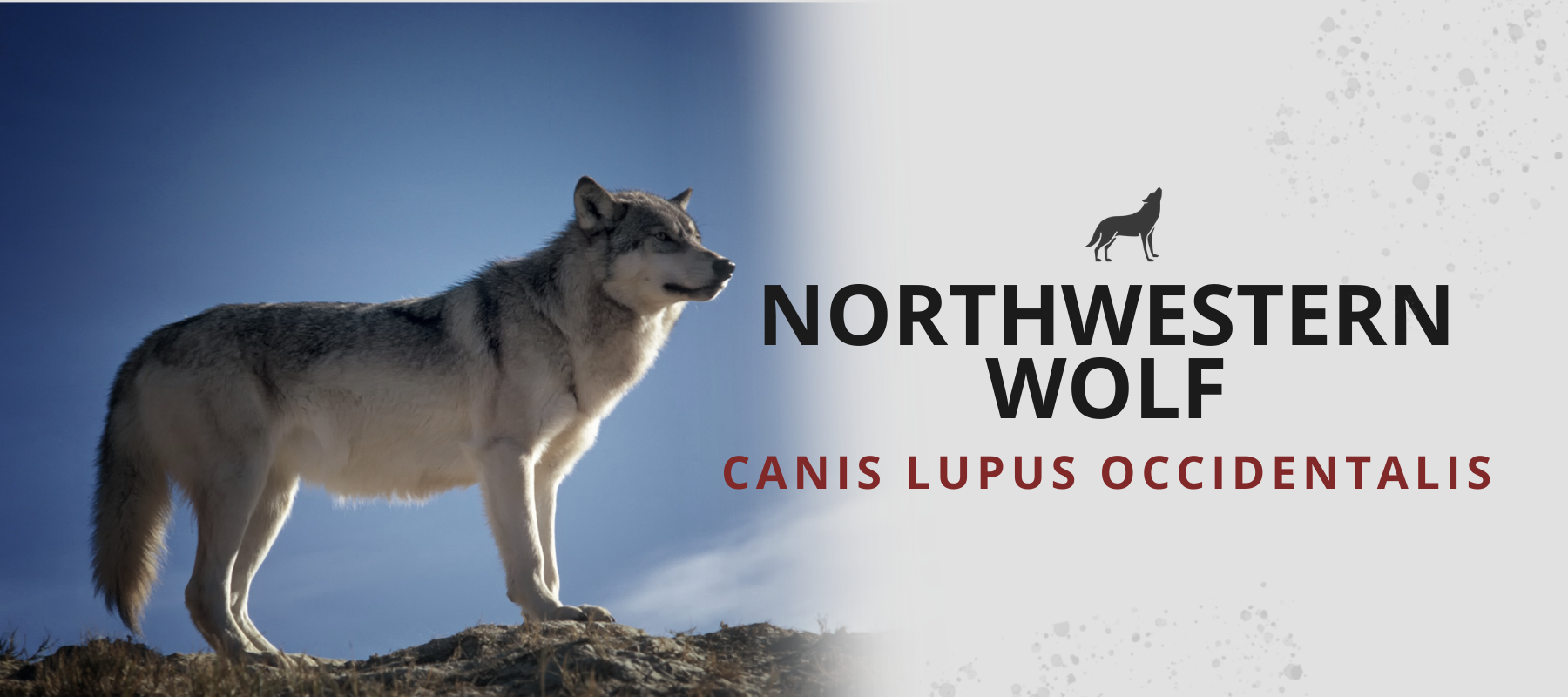
CANIS LUPUS CHANCO
The Tibetan wolf (Canis lupus chanco) is a subspecies of the gray wolf. This carnivorous mammal is described as a skilled and resourceful hunter by Tibetans who both respect and hate it. In the Tibetan epic "The Secret History of the Mongols", the Tibetan wolf is described with respect for its power, stealth and tenacity in its life as a hunter.
- Common name: Tibetan wolf
- Scientific name: Canis lupus chanco
- Other names: Mongolian wolf, Himalayan wolf
- Specie: Gray wolf
- Type: Mammals
- Diet: Carnivore
- Average size: 2.3 feet
- Weight: 105 to 121 lbs
TIBETAN WOLF DESCRIPTION
The Tibetan wolf size is on the average about 2,3 feet (70 cm) at the withers as an adult and weighs between 105 to 120 lbs (48 to 55 kg). This canid is not white like most Siberian wolves. Most Tibetan wolves are fawn colored, which gives them good camouflage in the desert areas where wolves live. They can also have black fur.
The largest wolf identified to date in Mongolia was no less than 6,5 feet (2 m) long from the tip of its snout to the end of its tail and weighed about 100 kg.

TIBETAN WOLF HABITAT
The Tibetan wolf species resides mainly in the treeless steppes, dry climate and poor grassy vegetation. It is also found in the boreal forests in the north of the country, in the Altai Mountains and in the semi-desert areas of the Gobi Desert.

TIBETAN WOLF DIET
The Tibetan wolf diet is strictly carnivorous. It eats any animal it can catch. Ungulates constitute most of this canine's diet, but it can also make do with smaller prey. To hunt large prey such as elk, Asian deer, horses and bulls, it hunts in wolf packs.
Contrary to popular belief, the wolf hunts for survival in Mongolia's harsh climate, not for pleasure. They mainly attack sick, weak or old animals or found carcass. By preying on sick individuals, wolves help strengthen herds and thus preserve the health of their potential prey.
Predation on domestic animals unfortunately also occur. This is also one of the reasons given by the natives to allow wolf hunting these that have become harmful to them and their livestock. The Tibetan government does not offer any compensation to the herders to avoid the extermination.

TIBETAN WOLF BEHAVIOR
Tibetan wolf behavior is similar to other gray wolf species. The pack defends and protects its territory against intruders. The size of their territory depends on the number of prey. If they are scarce, the territory can cover up to 2,100 km².
After a successful hunt the entire wolf pack eats until they are no longer hungry. Wolves can eat up to 9 kg of meat in a single meal. After that they can go without food for several weeks.

TIBETAN WOLF BREEDING
For this social animal, life in a pack goes on as it does for all wolf species. The dominance hierarchy is leaded by the alpha male. There is the dominant pair and each member of the pack has his own rank that he must respect. Alpha wolf is the only one who will do the wolf parade to mate with the female.
After gestation period, cubs feed on she-wolf’s milk for the first three weeks of their lives, then they start eating meat that the adults regurgitate. Later, when they will reach the sexuality maturity, wolf pups will follow the pack to hunt with them and learn about the hard life in the Tibetan steppes.

TIBETAN WOLF POPULATION
Mongolia has 2 million inhabitants and 30 million head of cattle. The lifestyle of the Tibetan people has always been based on nomadism. Despite the presence of wild ungulates such as deer, gazelle and ibex, domestic livestock is an important source of food for a predator such as the Tibetan wolf.
The Tibetan wolf population has been stable for years and in some areas has even increased, causing damage and persecution to populations and livestock. The Tibetan government does not pay compensation to ranchers for wolf damage. In February and May of each year the hunting season begins. A large hunt is organized to eradicate the wolf populations. A bounty is even offered for each wild wolf killed.
Unfortunately for this predator, there is no law protecting it in this country. If today the wolf populations in Mongolia are of an acceptable number, what will happen in the future if the slaughter continues? This carnivore will probably be added to the endangered species list which will follow up on a recovery plan and reintroduction of this species.

TIBETAN WOLF CONSERVATION PROGRAM
In the animal park of "Gevaudan", a center for biological diversity, few specimens of Tibetan wolves in captivity are currently visible. About fifteen of these wolves are present in the enclosure of the park and about sixty others are visible in a twenty-hectare conservation area located in Central Europe.
As an experiment, a protection zone was set up in the enclosure in 2007 to protect the omega individuals. The pack registered three births at the end of April 2008.
For a very long time, the Mongols considered the wolf as a majestic animal, which bewitched the spirit of the men but also as an enemy for their cattle. This is why many Tibetans have acquired skills and techniques for hunting and trapping this canidae.
"Wolf Management", a project of the Japanese International Corporation Agency, defenders of wildlife, and the Tibetan Ministry of the Environment is under way to research the gray wolf in Mongolia, and to formulate hunting laws as well as on the exploitation of nature in order to protect the wolf.
As the name suggests, the goal of the project is also to suggest a management plan, to help people "manage" nature and the environment through respect and appropriate treatment for the protection of wildlife.

TIBETAN WOLF TALES AND LEGENDS (The Blue Wolf)
In Mongolia empire, the wolf is, with the horse, an important animal in ancestral beliefs.
According to the beliefs, Börte Chino (in Tibetan language), also known as the Blue wolf, is the celestial wolf, agent of the sky and husband of the Deer doe Qo’ai Maral representing the Earth.
They have lived on the sacred mountain of the Mongols, the Burquan Qaldun, in the Khentei mountain range, located in the northen emisphere of Ulan Bator and south of Lake Baikal. The Blue Wolf also symbolized lightning.
According to a Tibetan legend, taken from the Tibetan chronicle of Siki-Quduqu in the 13th century, Genghis Khan, the great Tibetan conqueror, had for father the Blue Wolf Börte Chino. After his death, he would have gone to join him.
This is why, all the peoples who have known the Mongol influence have kept the wolf's memory of the ancestor. And when hunting leads them to shoot a wolf, the hunter will honor him by destroying the weapon that dealt the fatal blow because it has become evil.
If you want to learn more about wolves, we recommend you our blog post on the Northwestern wolf.




